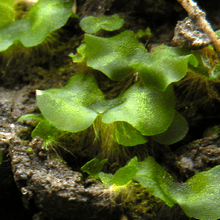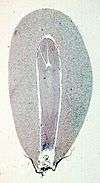Gametophyte
A gametophyte (/ɡəˈmiːtoʊfaɪt/) is one of the two alternating phases in the life cycle of plants and algae. It is a haploid multicellular organism that develops from a haploid spore that has one set of chromosomes. The gametophyte is the sexual phase in the life cycle of plants and algae. It develops sex organs that produce gametes, haploid sex cells that participate in fertilization to form a diploid zygote which has a double set of chromosomes. Cell division of the zygote results in a new diploid multicellular organism, the second stage in the life cycle known as the sporophyte. The sporophyte can produce haploid spores by meiosis.


Algae
In some multicellular green algae (Ulva lactuca is one example), red algae and brown algae, sporophytes and gametophytes may be externally indistinguishable (isomorphic). In Ulva the gametes are isogamous, all of one size, shape and general morphology.[1]
Land plants
In land plants, anisogamy is universal. As in animals, female and male gametes are called, respectively, eggs and sperm. In extant land plants, either the sporophyte or the gametophyte may be reduced (heteromorphic).[2]
Bryophytes
In bryophytes (mosses, liverworts, and hornworts), the gametophyte is the most visible stage of the life cycle. The bryophyte gametophyte is longer lived, nutritionally independent, and the sporophytes are typically attached to the gametophytes and dependent on them.[3] When a moss spore germinates it grows to produce a filament of cells (called the protonema). The mature gametophyte of mosses develops into leafy shoots that produce sex organs (gametangia) that produce gametes. Eggs develop in archegonia and sperm in antheridia.[4]
In some bryophyte groups such as many liverworts of the order Marchantiales, the gametes are produced on specialized structures called gametophores (or gametangiophores).
Vascular plants
All vascular plants are sporophyte dominant, and a trend toward smaller and more sporophyte-dependent female gametophytes is evident as land plants evolved reproduction by seeds.[5] Vascular plants such as ferns that produce only one type of spore are said to be homosporous. They have exosporic gametophytes—that is, the gametophyte is free-living and develops outside of the spore wall. Exosporic gametophytes can either be bisexual, capable of producing both sperm and eggs in the same thallus (monoicous), or specialized into separate male and female organisms (dioicous).
In heterosporous vascular plants (plants that produce both microspores and megaspores), the gametophyte develops endosporically (within the spore wall). These gametophytes are dioicous, producing either sperm or eggs but not both.
Ferns
In most ferns, for example, in the leptosporangiate fern Dryopteris, the gametophyte is a photosynthetic free living autotrophic organism called a prothallus that produces gametes and maintains the sporophyte during its early multicellular development. However, in some groups, notably the clade that includes Ophioglossaceae and Psilotaceae, the gametophytes are subterranean and subsist by forming mycotrophic relationships with fungi.
Lycophytes
Extant lycophytes produce two different types of gametophytes. In the homosporous families Lycopodiaceae and Huperziaceae, spores germinate into bisexual free-living, subterranean and mycotrophic gametophytes that derive nutrients from symbiosis with fungi. In Isoetes and Selaginella, which are heterosporous, microspores and megaspores are dispersed from sporangia either passively or by active ejection.[6] Microspores produce microgametophytes which the produce sperm. Megaspores produce reduced megagametophytes inside the spore wall. At maturity, the megaspore cracks open at the trilete suture to allow the male gametes to access the egg cells in the archegonia inside. The gametophytes of Isoetes appear to be similar in this respect to those of the extinct Carboniferous arborescent lycophytes Lepidodendron and Lepidostrobus.[7]
Seed plants
The seed plants (gymnosperms and angiosperms) are endosporic and heterosporous. The gametophytes develop into multicellular organisms while still enclosed within the spore wall, and the megaspores are retained within the sporangium.[8]
Heteromorphy
In plants with heteromorphic gametophytes, there are two distinct kinds of gametophytes. Because the two gametophytes differ in form and function, they are termed heteromorphic, from hetero- "different" and morph "form". The egg producing gametophyte is known as a megagametophyte, because it is typically larger, and the sperm producing gametophyte is known as a microgametophyte. Gametophytes which produce egg and sperm on separate plants are termed dioicous.
In heterosporous plants (water ferns, some lycophytes, as well as all gymnosperms and angiosperms), there are two distinct sporangia, each of which produces a single kind of spore and single kind of gametophyte. However, not all heteromorphic gametophytes come from heterosporous plants. That is, some plants have distinct egg-producing and sperm-producing gametophytes, but these gametophytes develop from the same kind of spore inside the same sporangium; Sphaerocarpos is an example of such a plant.
In seed plants, the microgametophyte is called pollen. Seed plant microgametophytes consists of several (typically two to five) cells when the pollen grains exit the sporangium. The megagametophyte develops within the megaspore of extant seedless vascular plants and within the megasporangium in a cone or flower in seed plants. In seed plants, the microgametophyte (pollen) travels to the vicinity of the egg cell (carried by a physical or animal vector), and produces two sperm by mitosis.
In gymnosperms the megagametophyte consists of several thousand cells and produces one to several archegonia, each with a single egg cell. The gametophyte becomes a food storage tissue in the seed.[9]
In angiosperms, the megagametophyte is reduced to only a few nuclei and cells, and is sometimes called the embryo sac. A typical embryo sac contains seven cells and eight nuclei, one of which is the egg cell. Two nuclei fuse with a sperm nucleus to form the endosperm, which becomes the food storage tissue in the seed.
See also
- Sporophyte – Diploid multicellular stage in the life cycle of a plant or alga
- Alternation of generations – Reproductive cycle of plants and algae
- Archegonium – Organ of the gametophyte of certain plants, producing and containing the ovum
- Antheridium – Part of a plant producing and containing male gametes
References
- Sadava, David; Hillis, David; Heller, H. Craig; Berenbaum, May (2012). Life: The Science of Biology, Volume 1 (10th ed.). Macmillan. ISBN 978-1464141225.
- Bennici, Andrea (2008). "Origin and early evolution of land plants". Communicative & Integrative Biology. 1 (2): 212–218. doi:10.4161/cib.1.2.6987. ISSN 1942-0889. PMC 2686025. PMID 19513262.
- Budke, J.M.; Goffinet, B.; Jones, C.S. (2013). "Dehydration protection provided by a maternal cuticle improves offspring fitness in the moss Funaria hygrometrica". Annals of Botany. 111 (5): 781–789. doi:10.1093/aob/mct033. PMC 3631323. PMID 23471009.
- Ralf Reski (1998): Development, genetics and molecular biology of mosses. In: Botanica Acta 111, pp 1-15.
- Stewart, W.N.; Rothwell, G.W. (1993-02-26). Palaeobotany and the evolution of plants, second edition. Cambridge, U.K.: Cambridge University press. ISBN 0521382947.
- Schneller, Jakob; Gerber, Hans; Zuppiger, Alex (June 2008). "Speed and force of spore ejection in Selaginella martensii" (PDF). Botanica Helvetica. 118 (1): 13–20. doi:10.1007/s00035-008-0814-6.
- Brack-Hanes, S.D. (1978). "On the megagametophytes of two Lepidodendracean cones". Botanical Gazette. 139: 140–146. doi:10.1086/336979.
- C.Michael Hogan (2010): Fern. Encyclopedia of Earth. National council for Science and the Environment Archived November 9, 2011, at the Wayback Machine. Washington, DC
- "Vascular Plants :: Description". Digimuse.nmns.edu.tw. Archived from the original on 2014-05-22. Retrieved 2014-07-13.
Further reading
- Roig-Villanova, Irma; Bou, Jordi; Sorin, Céline; Devlin, Paul F.; Martínez-García, Jaime F.«Identification of Primary Target Genes of Phytochrome Signaling. Early Transcriptional Control during Shade Avoidance Responses in Arabidopsis». Plant Physiology, 141, 1, 2006-05, pàg. 85–96. DOI: 10.1104/pp.105.076331. ISSN: 0032-0889.
- Cucinotta, Mara; Colombo, Lucia; Roig-Villanova, Irma (2014). "Ovule development, a new model for lateral organ formation". Frontiers in Plant Science. 5. doi:10.3389/fpls.2014.00117. ISSN 1664-462X. PMC 3973900. PMID 24723934.